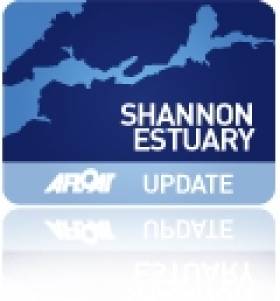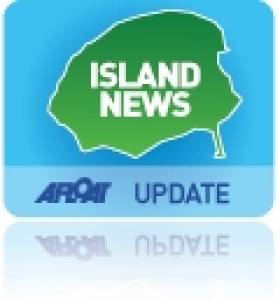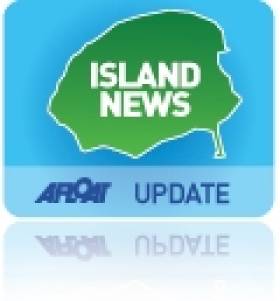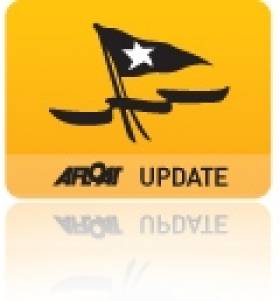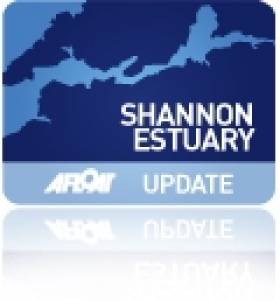Displaying items by tag: Shannon Estuary
#ShannonFoynes - The Limerick Leader reports on the Shannon Foynes Port Company's announcement of record profits in 2013.
Ireland's second largest bulk port company declared a 35% increase in its operating profits in the 12 months since its 2012 annual report, a record rise for the fourth successive year.
According to the port's CEO Patrick Keating, this strong performance underlines the objectives of the Vision 2041 master plan for the Shannon Estuary launched last year.
The Limerick Leader has more on the story HERE.
President Michael D Higgins has been in Limerick this week in honour of its status as Ireland's City of Culture 2014. In addition to other events, a highlight was his award of the Freedom of Limerick, something very special to him as he was born in the Shannonside port.
Ireland's Head of State is keenly aware of the Shannon and Limerick's rich maritime heritage, and he and his party spent almost an hour visiting the "Naumachia in the Cathedral", the exhibition in St Mary's Cathedral of the CityOne sailing dinghies built by trainees with the Ilen Boatbuilding School in the city.
The Ilen Boatbuilding School has several significant cultural aspects, as it was brought into being by Limerick designer Gary MacMahon and Brother Anthony Keane of Glenstal Abbey initially to teach boat-building skills by restoring the 1926-built 56ft ketch Ilen, which was designed by noted Shannon Estuary ocean voyager and adventurer Conor O'Brien.
But then as the work of the school developed, it took on the project of also building 23ft boats of the traditional Shannon gandelow type, specialized craft which evolved over the centuries to deal with the challenges of using the shallow and muddy waters of the Shannon Estuary with its exceptional tidal range.
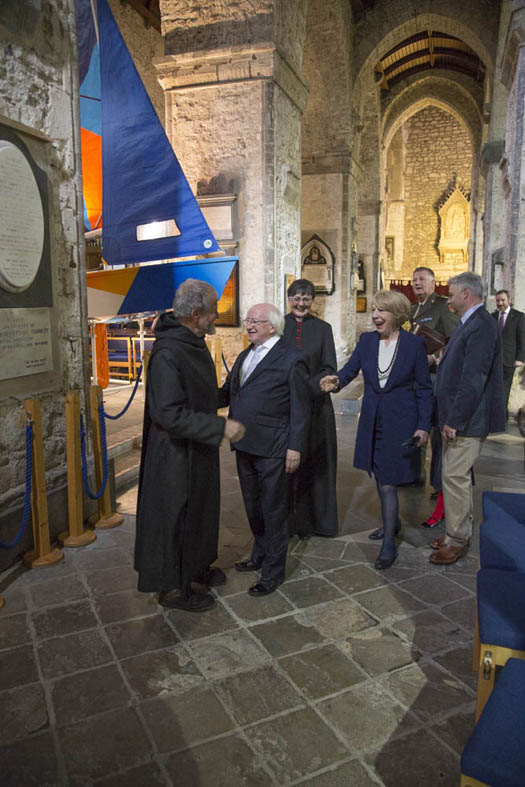
The President of Ireland is welcomed to the Naumachia in the Cathedral by Brother Anthony Keane of Glenstal Abbey. Also foreground are the Dean of Limerick the Very Reverend Sandra Bragnell, Mrs Sabina Higgins, and Gary MacMahon of Ilen Boatbuilding School.
It was the first time any new gandelows had been built in well over thirty years. This project was then further developed to build the CityOne Sailing Dinghies specifically for Limerick use, the unique design of these boats being drawn by naval architect Theo Rye to a detailed Limerick specification. With the new dinghies planned for completion at the height of Limerick's year as City of Culture, a CityOne International Graphic Arts Competition was also launched to create innovative ideas for the colour layouts on the sails and the hulls of the boats. It attracted 61 entries worldwide, and the four selected designs were from graphic artists in Kenya, Ireland Portugal and Texas.
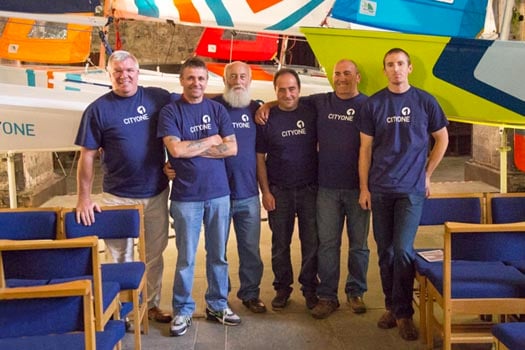
Participants in the Ilen School at the Cathedral included (left to right) Robert Smalle. Tony Broe, Liam O'Donoghue, James Madigan (Ilen School Instructor), Michael Grimes and Gary Wilmott.
It was the CityOne dinghies with their striking colour schemes which formed the centrepiece of the Naumachia in the Cathedral. But there were other exhibits linked to the many aspects of the Ilen School's work too, and in addition to meeting the boatbuilders and crews that sail the CityOnes, the President also met the "Gandelow Gang", who are drawn from the Limerick area both to make up the building teams for gandelows and CityOnes alike, and to row the gandelows in competition and traditional boat gatherings at home and abroad.
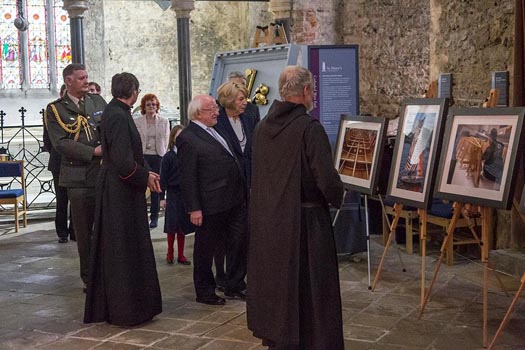
The Presidential party inspect the exhibits detailing the work of the Ilen School
In concluding his speech, the President summed up the mood of the day:
"I very much want to thank everyone involved in staging this exhibition here in this magnificent 12th Century building. What a great tribute it is to those who put all the original stones in place, that there is something new of the human spirit and craft being exhibited here. These boat builders, they are consummate craftsmen.
The international design dimension to the CityOne project is to be highly commended, and it is such a pleasure to be here with you today. I am delighted that the Ilen School project is part of the Limerick City of Culture. Isn't it wonderful that these skills are being passed down and developed, so that more and more people can take part, and for the community to see such inspiring craft?"
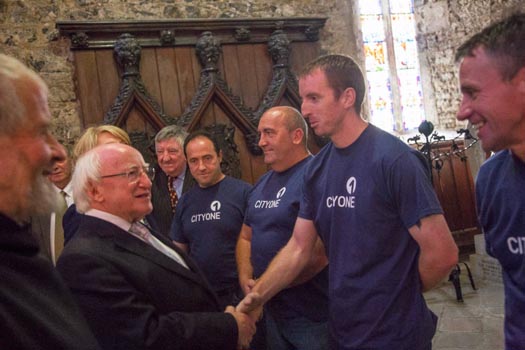
The President meets members of the Gandelow Gang and the Ilen Boatbuilding School including (left to right) James Madigan, Michael Grimes, Gary Wilmott and Tony Broe.
#scatteryisland Brian Ború's 10th century invasion of the monastic settlement of Scattery Island in County Clare and the subsequent killing of the Viking King of Limerick and his two sons will be recreated this weekend.
The Scattery Island Festival, which gets underway tomorrow morning and continues through Sunday, also features guided walks, lectures, music and song, and marine activities celebrating the island's association with St. Senan, the Vikings, Brian Ború, the Spanish Armada and later as a defence outpost for the British.
Uninhabited since 1979, Scattery Island - also known as Inish Cathaigh - is located approximately one mile from Kilrush in the Shannon Estuary and is home to a monastery founded in the early 6th century by St. Senan. The island features the ruins of six churches and one of the highest Round Towers in Ireland at 120 ft. high.
The re-enactment of the raid on the island by Brian Ború and his the Dál Cais army is the main event of the Scattery Island Festival, which is part of the national Brian Boru Programme and coincides with the millennial anniversary of Ború's death at the Battle of Clontarf in 1014.
Academics and historians have for many years argued whether or not Ború broke sanctuary by killing on church land as he sought revenge for the murder by King Ivar of his older brother and King of Munster, Mahon. Most agree however, that the incident consolidated Brian's position as Mahon's successor and helped him in his quest to become High King of Ireland.
Dr. Catherine Swift, Course Director, Irish Studies Mary Immaculate College explained: "The Annals of Inisfallen state that Ímar, king of the foreigners, and his two sons, were killed on Inis Cathaig by Brian, son of Cennétig in 977AD. In an account given in the Annals of Loch Cé meanwhile, Brian sees a vision of St Senán condemning him for breaking sanctuary by killing on church land which is taken to be this incident. Whatever one's opinion is of the manner in which the Norse King was slain, it is clear that his death paved the way for Brian to enjoy unchallenged rule over his home Province of Munster."
Rita McCarthy of the Scattery Island Heritage & Tourism Group said the re-enactment will be the focal point of this year's Festival, the theme of which is 'Invade Scattery'.
Also taking place during the course of the weekend will be a Ceremony of Remembrance for past inhabitants of the island, a Curragh Race, Music and Song with Inis Cathaigh Comhaltas, guided tours of the island by the OPW, talks on Scattery Island's environment and history, a Treasure Hunt for children, and tours to the Napoleonic Battery.
Ms. McCarhy continued: "We are inviting former island inhabitants and anyone with a connection with Scattery or indeed, its rich history to join us this weekend. Last year's inaugural festival, held as part of the Gathering Ireland initiative, proved to be a huge success with more than 5,000 people travelling to the island. This has helped to raise the profile of what has for many years been one of Ireland's least known monastic settlements."
The Scattery Island Festival is part-funded under the Community Tourism Diaspora Fund, operated locally by Clare County Council, IPB and Failte Ireland. For more visit www.brianborumillennium.ie, see Facebook (Scattery Island/Kilrush Gathering), or contact Rita McCarthy of the Scattery Island Heritage and Tourism Group on 087-9731162 / [email protected].
#cityone – The Ilen School CityOne Design Competition invites designers to submit designs for the sails and hull of a new CityOne performance sailing dinghy. Four of these CityOne dinghies are currently under construction through an innovative social educational programme in Limerick City.
As Afloat reported previously, The CityOne dinghy is a new performance dinghy, developed by the Ilen School and designed by naval architect Theo Rye as a legacy project of Limerick City of Culture 2014.
This exciting and challenging competition is open to all designers and high levels of creative freedom are encouraged for the task of designing a concept for application to the hull and sails.
Submissions must be sent by email to [email protected] There is no entry fee.
Three designs will be chosen by a judging panel and each single participant and group design chosen will receive €500* and enjoy the opportunity of seeing their designs creatively applied to the City One sail and hull before they take to the water for racing on the River Shannon, Limerick. The judging panel may also award additional non-monetary, special mentions.
Closing date for submissions Friday 25th July 2014. More on this on the City One competition page here.
#ScatteryIsland – Brian Ború's 10th century invasion of the monastic settlement of Scattery Island and the subsequent killing of the Viking King of Limerick and his two sons will be recreated in County Clare later this month.
The Scattery Island Festival on July 26th-27th also features guided walks, lectures, music and song, and marine activities celebrating the island's association with St. Senan, the Vikings, Brian Ború, the Spanish Armada and later as a defence outpost for the British.
Uninhabited since 1979, Scattery Island - also known as Inish Cathaigh - is located approximately one mile from Kilrush in the Shannon Estuary and is home to a monastery founded in the early 6th century by St. Senan. The island features the ruins of six churches and one of the highest Round Towers in Ireland at 120 ft. high.
The re-enactment of the raid on the island by Brian Ború and his the Dál Cais army is the main event of the upcoming Scattery Island Festival, which is part of the national Brian Boru Programme and coincides with the millennial anniversary of Ború's death at the Battle of Clontarf in 1014.
Academics and historians have for many years argued whether or not Ború broke sanctuary by killing on church land as he sought revenge for the murder by King Ivar of his older brother and King of Munster, Mahon. Most agree however, that the incident consolidated Brian's position as Mahon's successor and helped him in his quest to become High King of Ireland.
Dr. Catherine Swift, Course Director, Irish Studies Mary Immaculate College explained: "The Annals of Inisfallen state that Ímar, king of the foreigners, and his two sons, were killed on Inis Cathaig by Brian, son of Cennétig in 977AD. In an account given in the Annals of Loch Cé meanwhile, Brian sees a vision of St Senán condemning him for breaking sanctuary by killing on church land which is taken to be this incident. Whatever one's opinion is of the manner in which the Norse King was slain, it is clear that his death paved the way for Brian to enjoy unchallenged rule over his home Province of Munster."
Rita McCarthy of the Scattery Island Heritage & Tourism Group said the re-enactment will be the focal point of this year's Festival, the theme of which is 'Invade Scattery'.
Also taking place during the course of the weekend will be a Ceremony of Remembrance for past inhabitants of the island, a Curragh Race, Music and Song with Inis Cathaigh Comhaltas, guided tours of the island by the OPW, talks on Scattery Island's environment and history, a Treasure Hunt for children, and tours to the Napoleonic Battery.
Ms. McCarhy continued: "We are inviting former island inhabitants and anyone with a connection with Scattery or indeed, its rich history to join us on the weekend of July 26-27th. Last year's inaugural festival, held as part of the Gathering Ireland initiative, proved to be a huge success with more than 5,000 people travelling to the island. This has helped to raise the profile of what has for many years been one of Ireland's least known monastic settlements."
The Scattery Island Festival on July 26th-27th is part-funded under the Community Tourism Diaspora Fund, operated locally by Clare County Council, IPB and Failte Ireland. For more visit www.brianborumillennium.ie, see Facebook (Scattery Island/Kilrush Gathering), or contact Rita McCarthy of the Scattery Island Heritage and Tourism Group on 087-9731162 / [email protected].
#rdirl – A father and son duo from Listowel in County Kerry are taking on the double-handed challenge in this year's Round Ireland Yacht Race. The pair Derek Dillon and son Conor, a 19–year–old Univesity of Limerick student, will race the family Dehler 34 'Big Deal' that is based on the Shannon Estuary.
The Foynes Yacht Club pairing have been racing together inshore for over ten years, and have competed at numerous ICRA's, Cork Weeks and Calves Weeks. The pair are sponsored by leading marine supplier, Union Chandlery.
They recently made the move into offshore racing, enjoying recent success in multiple ISORA Qualifying races.
'We look forward to the competitive adventure associated with doing such an endurance race, double- handed', father Derek told Afloat.ie
The pair also plan to compete in the Volvo Cork Week double-handed and compete fully-crewed in Cork Dry Gin Calves Week, in which they have finished first in class in the past two consecutive years.
#foynes – At Foynes Yacht Club on the Shannon Estuary this coming bank holiday weekend the Munster Mermaid championships will take place writes Gerry Ryan of Foynes Yacht Club
This event will be run over two days, Saturday and Sunday, and Officer-of-the-day, Liam Madden has two days of spectacular racing planned on the Shannon estuary.
On Saturday two races will take place east of Foynes Island in an Olympic triangular course, and on Sunday one race is scheduled in Foynes harbour, so that the public can view this spectacular sport.
A total of twelve boats will be competing over the two days, with seven coming from the east coast and the remainder from FYC.
Class captain, Darragh McCormack is hoping for magnificent weather and competitive racing for the event.
This year the Mermaid's will be joined by our friend's from Kildysart, will be sailing currachs to Cooleen Point for the festivities. They will also be racing in the harbour as part of the Foynes Irish Coffee festival.
Fixtures for the month of June at Foynes: On all Wednesday's in June the summer league will take place. Saturday 14, Foynes to Fenit race. Saturday 21 cruise and Bar-b-que. Saturday 28 Foynes to Cappa.
#shannonestuary – On Sunday last at Foynes Yacht Club on the Shannon Estuary, Commodore's Day was held with a superb turnout of member's and the public to make the day one of the best in the annals of the club writes Gerry Ryan. With the weather extremely windy for the occasion, it did not dampen the proceedings that went underway.
Racing started at 1.45 for all classes with the officer's of the day, John-Joe Buckley and John Conway sending the classes east of the island for racing. The start line was between Barneen Point and Foynes basin town landing position, and the racing finished at the Club line from the west.
Class 1 raced started at the club line and raced up to elbow rock to long rock taking in the 8 metre mark, Cahercon, table rock and Sturamus around the island and finishing at the club line.
Class 2 had a slightly shorter course with them starting at the club line sailing to the elbow rock, long rock, Innismurray, table rock, Sturamus and then back to the finish line.
With a force 5/6 gale force breeze and gusting this certainly tested the boats and sailors for the racing.
The Paddy Reidy Cup was won by Battle with John-Paul Buckley at the helm; second was Darragh McCormack, who skippered Maximus, and third was Hello skippered by Liam Madden.
In Class 2 the trophy was that was raced for was the Thoroughbred trophy sponsored by Nash's Bakery, and this was won by Alpara skipperd by the Commodore James McCormack; second was Pat Finucane on Marengo and third was Brian O'Donnell on Whyte Dolphin.Club Topaz dinghies and kayaks also took to the water under the watchful eye of Simon McGibney and club secretary Elaine O'Mahoney on the ribs.
After the racing the blessing of the boats was administered by Canon O'Keeffe and Fr. Noonan at the marina, and this was followed by a bar-b-que on the club lawn, which culinary chef Timmy Shanahan served up the best of west Limerick beef.
The Commodore thanked all who had helped out with the proceedings on the day and wished everybody the best of luck for the season.
Foynes Yachts to Sail to Limerick for Riverfest Celebrations
#foynesyachtclub – This coming weekend a flotilla of yachts will sail from Foynes to Limerick city as part of the annual Riverfest celebrations, which is in its tenth year. Some of the yachts will be sailing on Friday, while the remainder will sail up with the tide on Saturday, berthing at Steamboat Quay for an hour before entering Limerick docks, to berth overnight. This has been an annual trip for members of the yacht club.
#foynes – With the vessels launched on Saturday last the sailing season is getting underway for Foynes Yacht Club writes Gerry Ryan.
Quite an interesting programme of fixtures are scheduled for what is described to be an 'adventurous season ahead'.
Commodore James McCormack, is looking forward to a very good season of sailing for all members.
First on the calendar is the 'competent crew and sailing course' for new member's, and this will start on Wednesday, April 30 at 8pm for registration.
On the following Wednesday evening, May 7 the course starts with a free 'dry night' for adult participants when all the rudiments of boating, sailing and water activity will be discussed and the full details of the course programme will be outlined.
On Wednesday, May 7 a programme of six to eight nights of 'on the water' activity and training will commence. This programme will have participants at competent crew level to take up whatever water based activity they wish to pursue.
Number's are limited due to the number of craft available, so any new member's who wish to pursue the course are asked to send a text to 086 2568280 with an email address and mobile number as soon as possible.
It is important to note that the ultimate sailing event: Commodore's Day will be on Sunday, May 11. This is a very prestigious event in the sailing calendar, and all member's are asked to participate on the day.
Foynes YC Fixtures for May:
Friday 2: annual cruise to Limerick.
Wednesday 7: All classes the 'May Series' of racing begins for the Magabar and Griffin Cups.
Sunday 11: Commodore's Day: All classes race for the Paddy Reidy Cup, and the Mermaid's will be racing for the Michael Synnott memorial trophy.
The Estuary Bell will take place over two days on Saturday 24-two races are scheduled, and on Sunday 25 one race will take place between FYC and the Royal Western Yacht Club, Kilrush.


























